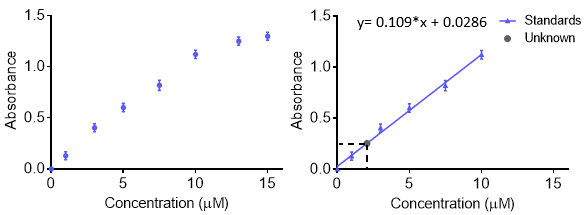Kalibrierkurven
Überblick
Quelle: Labor von Dr. B. Jill Venton - University of Virginia
Kalibrierkurven werden verwendet, um die instrumentelle Reaktion auf eines Analyten zu verstehen und vorherzusagen, die Konzentration in einer unbekannten Probe. In der Regel eine Reihe von standard-Proben sind in verschiedenen Konzentrationen mit einer Reihe gemacht, als unbekannte Sehenswürdigkeiten beinhaltet und die instrumentelle Reaktion bei jeder Konzentration wird aufgezeichnet. Für mehr Genauigkeit und den Fehler zu verstehen kann die Reaktion bei jeder Konzentration wiederholt werden, so eine Fehler Bar erreicht wird. Die Daten werden dann mit einer Funktion passen, so dass unbekannte Konzentrationen vorausgesagt werden können. In der Regel die Antwort ist linear, jedoch eine Kurve kann mit anderen Funktionen gemacht werden, solange die Funktion bekannt ist. Die Eichkurve kann verwendet werden, zur Berechnung der Nachweisgrenze und Begrenzung der Quantifizierung.
Wenn Sie Lösungen für eine Eichkurve, kann jede Lösung separat erfolgen. Jedoch kann das eine Menge des Ausgangsmaterials und zeitaufwendig sein. Eine weitere Methode zur Herstellung von vielen verschiedener Konzentrationen einer Lösung soll serielle Verdünnungen verwenden. Eine konzentrierte Probe verdünnt mit Verdünnungsreihen unten in gewissem Sinne schrittweise niedrigere Konzentrationen zu machen. Das nächste Beispiel besteht aus den vorherigen Verdünnung und der Verdünnungsfaktor oft konstant gehalten. Der Vorteil ist, dass nur eine erste Lösung erforderlich ist. Der Nachteil ist, dass etwaige Fehler in der Lösung machen — pipettieren, massing, etc. – erhalten propagiert, da weitere Lösungen hergestellt werden. Daher muss darauf geachtet werden, wenn die erste Lösung zu machen.
Verfahren
1. machen die Standards: Verdünnungsreihen
- Machen Sie eine konzentrierte Stammlösung der Norm. Das Mittel ist in der Regel genau abgewogen, und dann quantitativ in einem volumetrischen Kolben übertragen. Fügen Sie einige Lösungsmittel hinzu, mischen Sie, so dass die Probe auflöst, dann füllen Sie in die Zeile mit dem entsprechenden Lösungsmittel.
- Durchführen Sie Verdünnungsreihen. Nehmen eine andere volumetrischen Kolben und pipette die Höhe der Standard für die Verdünnung benötigt dann füllen Sie i
Anwendung und Zusammenfassung
Kalibrierkurven sind in vielen Bereichen der analytischen Chemie, Biochemie und pharmazeutische Chemie eingesetzt. Es ist üblich, sie mit Spektroskopie, Chromatographie und Elektrochemie Messungen verwenden. Eine Eichkurve kann verwendet werden, um die Konzentration einer Umweltbelastung in einer Bodenprobe zu verstehen. Es kann verwendet werden, bestimmen die Konzentration der Neurotransmitter in einer Stichprobe von Gehirn Flüssigkeit, Vitamin in pharmazeutische Proben oder Koffein in Essen. Somit eignen sich Kalibri..
pringen zu...
Videos aus dieser Sammlung:

Now Playing
Kalibrierkurven
Analytical Chemistry
797.0K Ansichten

Probenvorbereitung für die analytische Charakterisierung
Analytical Chemistry
84.8K Ansichten

Interne Standards
Analytical Chemistry
204.8K Ansichten

Standard-Additionsverfahren
Analytical Chemistry
320.2K Ansichten

UV/Vis-Spektroskopie
Analytical Chemistry
623.7K Ansichten

Raman-Spektroskopie für die chemische Analyse
Analytical Chemistry
51.2K Ansichten

Röntgen-Fluoreszenz (XRF)
Analytical Chemistry
25.4K Ansichten

Gaschromatographie (GC) mit Flammen-Ionisations-Detektion
Analytical Chemistry
282.1K Ansichten

Hochleistungs-Flüssigkeitschromatographie (HPLC)
Analytical Chemistry
384.6K Ansichten

Ionenaustausch-Chromatographie
Analytical Chemistry
264.6K Ansichten

Kapillarelektrophorese (CE)
Analytical Chemistry
94.0K Ansichten

Einführung in die Massenspektrometrie
Analytical Chemistry
112.3K Ansichten

Rasterelektronenmikroskopie (SEM)
Analytical Chemistry
87.2K Ansichten

Elektrochemische Messungen von Trägerkatalysatoren mit einem Potentiostat / Galvanostat
Analytical Chemistry
51.4K Ansichten

Zyklische Voltammetrie (CV)
Analytical Chemistry
125.3K Ansichten
Copyright © 2025 MyJoVE Corporation. Alle Rechte vorbehalten
